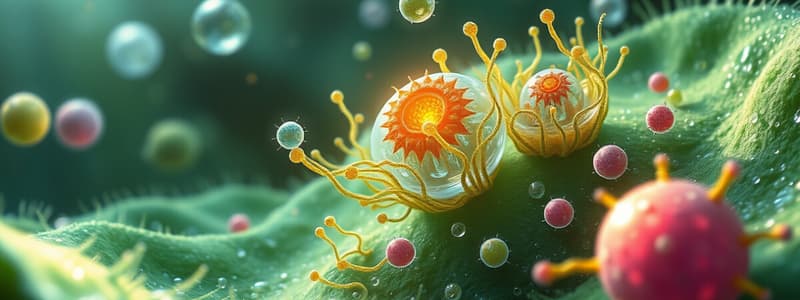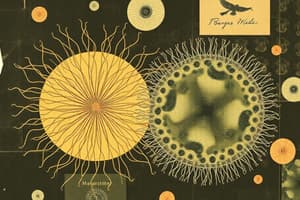Podcast
Questions and Answers
What is a unicellular organism and how does it perform its life activities?
What is a unicellular organism and how does it perform its life activities?
A unicellular organism, like Amoeba, is composed of a single cell that performs all basic life activities such as movement, digestion, and respiration within that one cell.
Explain the concept of division of labor in multicellular organisms.
Explain the concept of division of labor in multicellular organisms.
In multicellular organisms, such as humans, there is a division of labor where different groups of specialized cells perform specific functions, improving efficiency.
What are tissues, and how are they formed?
What are tissues, and how are they formed?
Tissues are groups of similar cells that work together to perform a specific function, formed from cells with a common origin.
Who coined the term 'tissue,' and in what year?
Who coined the term 'tissue,' and in what year?
Describe the role of nerve cells in nervous tissue.
Describe the role of nerve cells in nervous tissue.
How does tissue formation improve the efficiency of multicellular organisms?
How does tissue formation improve the efficiency of multicellular organisms?
What is the origin of nerve cells in the human body?
What is the origin of nerve cells in the human body?
What are some examples of tissues found in the human body?
What are some examples of tissues found in the human body?
Study Notes
Cellular Organization
- All living organisms consist of cells, which are the basic structural and functional units of life.
- Unicellular organisms, like amoeba and paramecium, are composed of a single cell that performs all necessary life functions.
- In amoeba, a single cell manages movement, food intake, gas exchange (O2), digestion, metabolism, and reproduction.
Multicellularity and Division of Labor
- Multicellular organisms, such as humans, consist of millions of specialized cells, resulting in a division of labor.
- Different cell types undertake specific functions to enhance efficiency.
- Muscle cells facilitate movement.
- Nerve cells transmit messages within the body.
- Blood cells transport oxygen, nutrients, hormones, and waste products (CO2, urea).
- In plants, specialized cells in tissues, like xylem and phloem, transport nutrients and water.
Tissue Formation
- Tissues are groups of similar cells working together to perform specific functions.
- All cells in a tissue share a common origin.
- The term "tissue" was coined by histologist Bichat in 1792; the study of tissues is known as histology.
Nervous Tissue
- Human nervous tissue is primarily located in the brain, spinal cord, and nerves.
- Neurons, the main component of nervous tissue, consist of:
- A cell body (soma) containing the nucleus.
- Dendrites that receive signals.
- An axon that transmits signals away from the soma.
- All neurons originate from a germinal layer called ectoderm.
Significance of Tissues
- The formation of tissues allows for specializations, improving efficiency and organizing into organs and organ systems.
- This organization reduces the workload of individual cells, allowing multicellular organisms to operate more efficiently and enhancing their survival.
Studying That Suits You
Use AI to generate personalized quizzes and flashcards to suit your learning preferences.
Description
Explore the fundamental concepts of cells in Chapter 3 of Biology. This quiz covers unicellular organisms like amoeba and paramecium, highlighting how a single cell performs all life activities. Additionally, it contrasts this with the complexity of multicellular organisms such as human beings.




